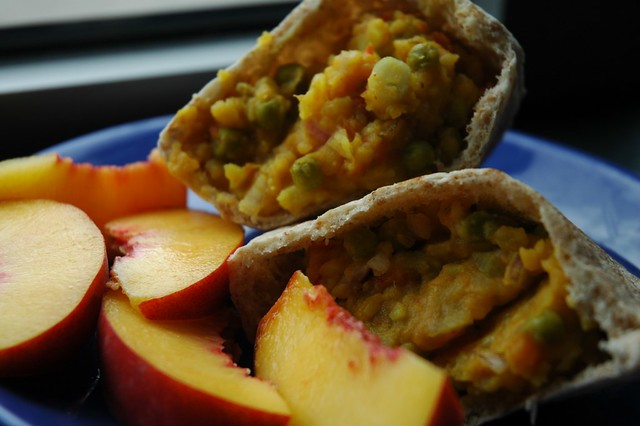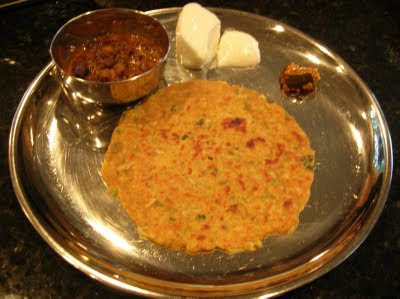
This dish, pav bhaji, takes me back to the day...
Growing up our family ate Gujarati food everyday. Of course Indian food wasn't cool back then, with all of our hand-eating and what not. We ate roti, that I had to constantly explain was like a tortilla, but not; then we had mixed vegetable dishes (shak-bhaji), rice (bath), and dhal (a rotating variety of about 3 kinds, tuver, mung, and channa), then we'd eat yogurt, which my sister and brother would substitute with Cool Whip (haha shak-bhaji with Cool Whip) oh a Seestah classic. We'd have a small salad consisting of radish, carrots, cucumbers and lime juice with cumin and red chili, then pickled mangoes, and sometimes pickled turmeric root that would stain your hands and teeth. And yeah we ate all of this with our hands. It was an embarrassing time to be the only brown kids in your neighborhood (and town). At every chance, my best friend neighborino Christie and I would sneak and trade dinners at least 3 nights a week. I hated the atrocious food my mom would force us to eat, and Christie loved it. While she could eat shak bhaji and roti, I would get her lovely turkey lasagna. She got chutney cucumber sandwiches, I got 3-bean pasta salad, she'd get kitchari, I'd get spaghetti. You'd have to get there early because it was sure to run out (with her 6 brothers and sisters). Oh Christie, you remember those days. Melissa, you too. At least 1 or 2 days out of the week, we'd have leftovers, and we kids would be forced to eat it. Oh. THE ATROCITIES! That was mom, cooking every meal, then re-serving them later in the week.
Then when I was 12, I spent an entire summer in India, eating only Indian foods (we tried pizza once, but the pizza had ketchup for sauce, and shredded Amul cheese on top). I didn't have an epiphany, I just got to experience why my parents loved it so much. Being there, every meal was cooked fresh, and came with 5-6 different dishes. And instead of complaining about the food, my cousins, aunts, uncles and grandparents just ate it. No big deal. It was like the best damn Indian buffet you had every gone to. I think this (and later living in Houston for 8 years) set me straight.
My parents now live 3000 miles away from me, and I don't ever get to eat their yummus food, but I do make sure and call to see what meals their eating and cooking and mostly to get mom to tell me how to make this or that. This last time she was making Pav Bhaji, I had to make it, and then write about it. It's really simple, and everything comes together, and the best part is you can host a lot of hungry people with this dish.
Getting her (or really any Indian auntie) to tell me how to prepare something goes somewhat like this: :
Neeli: Mom so how do I make the pav bhaji?
Mom: beta, it is so simple, just put cauliflower and few potatoes in cooker and set for only 1 whistle. Then save that water, you can use it to thicken it later. You've never made? I packed you the pav bhaji spice, it is so simple.
Neeli: OK, but my cooker is broken.
Mom: Oh. boil it!
Neeli: OK, then what?
Mom: Just put in mixed vegetable bag with some tomatoes and just 1-2 spoonfuls of pav bhaji and you can add whatever other spices by smelling and tasting it. Make sure you use enough potatoes.
Neeli: how important are the potatoes?
Mom: Very! you must have potatoes in this dish. So how many you have? Oh and remember to put masalu (this is code for the holy trinity, chili, ginger, garlic). You can add onion too.
They'll never tell you all the spices or all the steps. Pretty much every dish she has every told me goes a lot like that. Getting food to taste right means tasting it, looking at it, and smelling it. I've never gotten exact measurements, but when she explains it this way, something in me gets it, and the dishes that come out when I think of her, would amaze her. I hope you'll try this, and let me know how it turns out
Pav Bhaji or Indian-style veggie burgers
Ingredients:(Note: if you don't have bell peppers or carrots, just toss in a frozen bag of peas and carrots or mixed vegetables. You can buy the Pav Bhaji masala mix at a South Asian grocery store, just read the label to make sure it has no added salt)
2 potatoes, peeled and cubed (russets or baking potatoes are best because of their fancy starch content)
1 large head cauliflower, cut into big chunks
1 or 2 small bell peppers, diced fine
jalapeno, seeds and veins removed, chopped
garlic, smashed
ginger, grated or minced fine
tomatoes (1 can, diced)
carrot, diced fine
1-2 T pav bhaji masala mix
1-2 t salt
1/2 t turmeric
1 T cumin
2 limes or lemons. Squeeze one of them, and slice the other in wedges for garnish
2 medium sized onions, chopped fine. Set aside 1 cup for garnish
2-3 T butter (more or less)
water
1/2 cup chopped cilantro
good quality hearty hamburger buns, or some hearty crusty bread
butter for the bread
Directions:
- Option 1: put potatoes and cauliflower in a pressure cooker and set for 1 whistle.
- Option 2: Heat a large stockpot with water, and boil potatoes and cauliflower together until soft enough to mash. Reserve the water from either method above. Mash when still warm - watch out for spurts, they'll burn.
- In another stockpot, melt the butter, and add onions, garlic, ginger, and jalapeno. Saute about 5 minutes. Next add in carrots and tomatoes. Add pav bhaji mix through cumin. Taste and adjust seasonings if you need more salt, or pav bhaji mix (if you want it spicier) It may taste bland at this point.
- Add in mashed potato and cauliflower mixture, lime or lemon juice, and more water if the mixture is too dry. Bring to a simmer, continue cooking 10-15 minutes
- Meanwhile, butter the bread rolls and assemble garnishes in bowls or on a platter. Bake the rolls until crispy and soft.
- Taste and adjust seasonings if necessary. You may want to stir in a little bit more butter, some lime juice, or salt. Garnish with the chopped cilantro and serve in bowls along with the bread, onions and lime.
- They are best open-faced and topped with onions and squeeze of lime.

















